Technology has enabled TVs to become ever flatter, thinner, and lighter, but it can’t overcome the laws of physics when it comes to audio. Filling a room with sound requires substantial speakers that can move a lot of air, and those types of speakers just won’t fit inside a thin TV chassis. That’s where soundbars come in.
We’ll explain all the latest soundbar technology, show you the most important features you should look for, and name our top picks in budget, mid-range, and high-end categories. We’ll also provide links to all our reviews of soundbars currently on the market, so you can find exactly the right one for your needs.
Here are our current top picks, with brief summaries explaining our reasoning. These will change over time as new models come in for evaluation. Our soundbar reviews will go into some depth, so we encourage you to follow the links to read them in their entirety. Beneath our top picks you’ll find some general guidance about soundbars, followed by explanations of the features you should consider when choosing one. Links at the bottom of the page will take you the rest of our soundbar reviews.
Updated August 28, 2019 to add our review of the JBL Link Bar, the result of a 15-month collaboration between Google and JBL that combines a Google Assistant smart speaker and an Android TV video-streaming box into a Chromecast-enabled soundbar. Unfortunately, we quickly discovered that the JBL Link Bar was not worth the wait, as it makes far too many compromises in its effort to be an all-in-one home audio solution.
Best budget soundbar
Yamaha’s YAS-108 soundbar delivers great sound in a small and affordable package, and unlike most competitors at this price point, it has a wired subwoofer output so you can beef up its low end with just about any aftermarket sub. And if you own a 4K UHD TV, you’ll be happy to learn that this soundbar can pass HDR information through to your big-screen TV. Support for dual simultaneous Bluetooth device connections lets you instantly switch from one smartphone or tablet to another. The only feature that’s missing: Wi-Fi support for Yamaha’s excellent MusicCast multi-room audio system.
Runner-up
Samsung’s entry-level soundbar doesn’t have as many features as Yamaha’s similarly priced offering, but it does come with a wireless subwoofer, which makes it easy for us to recommend as the runner-up in this category. It’s a particularly good choice if you have one of Samsung’s lower-priced smart TVs.
Best mid-range soundbar
Our previous pick in this category—the JBL Cinema SB 450—is no longer available, so we moved up Yamaha’s YAS-207 to take its place. This soundbar-with-wireless-subwoofer combo delivers immersive audio, in the form of DTS Virtual:X at a phenomenal price.
Runner-up
The Sonos Beam is our runner-up pick for best mid-priced soundbar. It’s a powerful speaker for its size, and you can expand it into a full-fledged 5.1-channel system by adding a wireless sub and wireless surround speakers. The Beam also has built-in support for Amazon’s Alexa digital assistant (and it will soon support Google Assistant), so it can become a key element in your smart home system. Apple fans, meanwhile, will appreciate the Beam’s support for AirPlay 2.
Best high-end soundbar
Last year’s model of this speaker was our top pick in this category, at least until Yamaha’s YAS-706 knocked it off its perch. But Denon fired back with an all-new version—the HEOS HomeCinema HS2—and quickly won us over again. This smart soundbar features Amazon Alexa integration, but that’s just the tip of the iceberg. It’s crystal clear sound, strong multi-room audio features (including support for Apple’s AirPlay 2) and powerful subwoofer maker for a winning combination.
Runner-up
Vizio reinforces this soundbar with not only a beefy subwoofer, but also a pair of (wired) surround satellite speakers. Upfiring speakers in the soundbar itself bounce Dolby Atmos height audio effects off your ceiling to deliver a truly immersive audio experience with soundtracks that support that object-based codec. And Vizio offers all this for just $500. It’s a remarkable value.
Best soundbase
A soundbar isn’t the right audio experience for every TV viewer. If you want a very good audio performance–including strong bass performance, without need for a separate subwoofer–a soundbase might be what you’re looking for. Fluance’s AB40 Soundbase is our current top pick in this category, boasting a fabulous price/performance ratio by virtue of its $250 price tag and excellent audio capabilities.
What exactly is a soundbar?
A soundbar is typically a one- or two-piece speaker system whose primary purpose is to bring quality sound back to modern TVs (two-piece systems include a subwoofer). They’re designed to appeal to people who can’t (because of the wiring requirements and/or expense associated with traditional home theater audio) or won’t (because they object to the visual intrusion an A/V receiver and six or more loudspeaker cabinets presents) install freestanding speakers.
The audio performance of nearly any soundbar will surpass the quality of just about any modern TV while consuming minimal space and requiring little more than a power cord and one or two cables. Soundbars are designed to fit in front of your TV if your TV is resting on a piece of furniture, or beneath your TV if it’s hanging on the wall. There’s also a subcategory—the soundbase—that can support the weight of your TV. You can even find soundbars from TV manufacturers that are designed to match the aesthetic of the TV it’s paired with.
 Zvox
ZvoxZvox SB500 soundbar
Nearly all modern TV and movie soundtracks are recorded in surround sound, so most soundbars are equipped to decode at least Dolby Digital and play back discrete left, right, and center channels, plus low-frequency effects (LFE). A great many models include a separate self-amplified subwoofer to handle LFE, which establishes a wireless connection with the soundbar. Purchasing a soundbar doesn’t necessarily mean you’ll miss out on a full home-theater experience; in fact, some models offer optional surround speakers and others can even support object-oriented codecs, such as Dolby Atmos and DTS:X, that deliver a sensation of height.
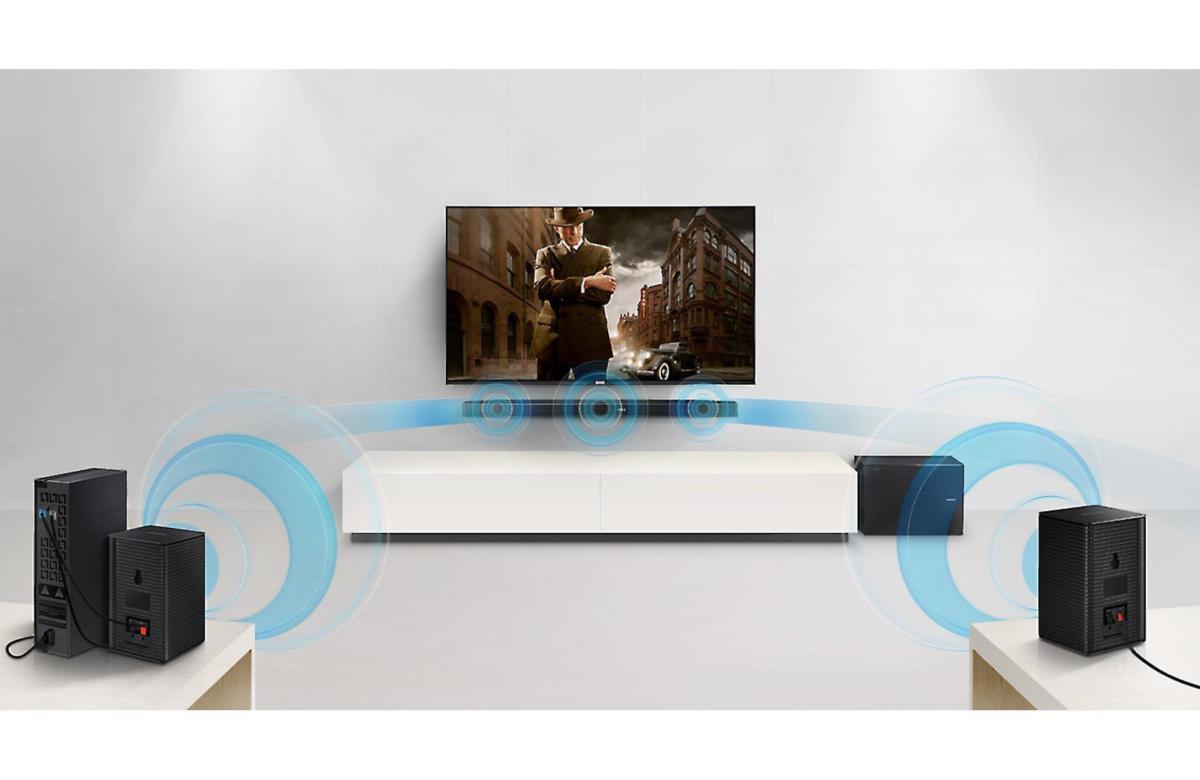 Samsung
SamsungSamsung’s SWA-8500S wireless speaker kit to its HW-M450 soundbar adds left and right surround speakers without the need to run cables to the back of your room.
How does a soundbase differ from a soundbar?
Search for soundbars and you’ll see some models described as a “soundbase.” The two are similar—and they might even share identical technological feature sets—but they’re not the same thing. Unlike a soundbar, a soundbase is specifically designed to sit on a cabinet and support the weight of a television. Their form factor means they can’t be mounted to the wall.
What size soundbar should I buy?
Most people buy a soundbar that is either the same width or narrower than their TV, but that really has more to do with aesthetics than audio performance. If your TV is on a piece of furniture, and you’re buying a soundbar that will sit in front of it, you need to take the speaker’s height into consideration, so that it doesn’t encroach on the screen or block the TV’s infrared receiver. Sound soundbars include an IR repeater for this reason. If you’re shopping for a soundbase, you need to make sure that the speaker will fit in the space you have for it, and that it can bear the weight of your TV.
Everything else being equal, the smaller the sound soundbar or soundbase, the less room it has for larger speakers and features (codec support, wireless connectivity, multiple inputs and outputs, and so on). That’s not to say that a bigger speaker will always sound better than a larger one, of course.
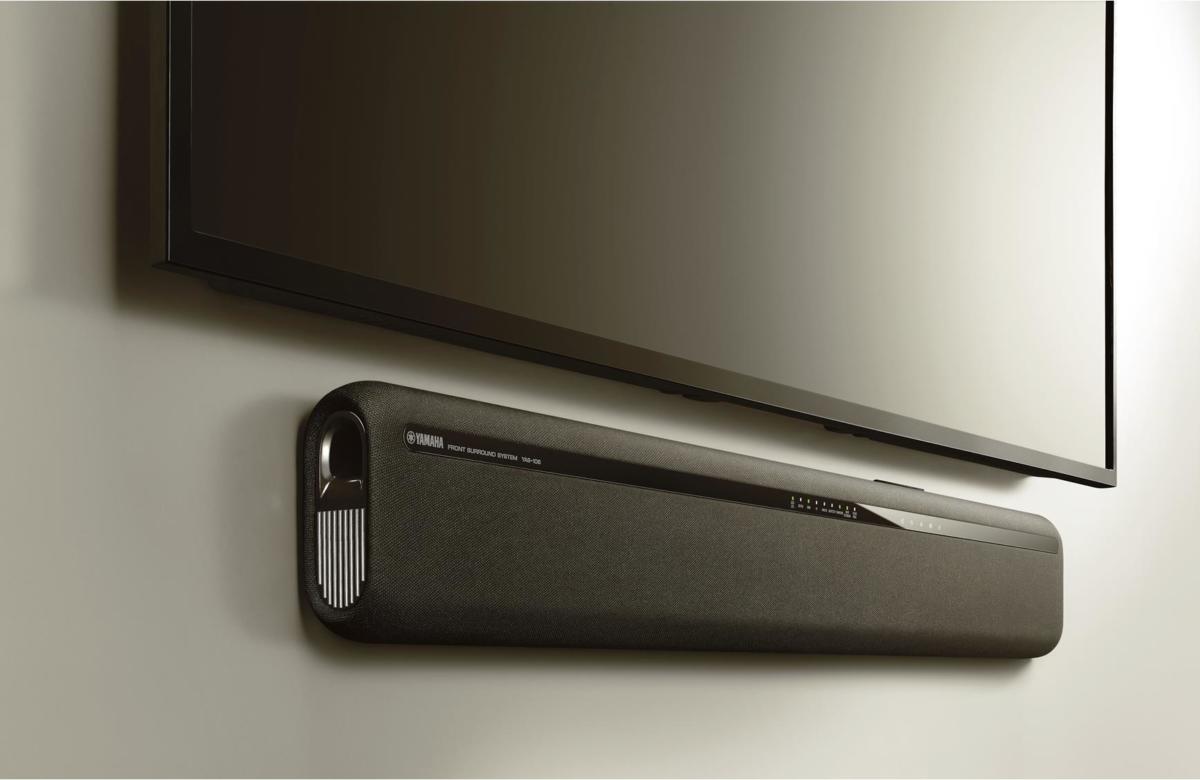 Yamaha
YamahaThe Yamaha YAS-106 can be wall-mounted with a thin profile to match modern TVs.
Do soundbars support Dolby Atmos and DTS:X?
Buying a soundbar doesn’t mean you need to give up an immersive home theater experience, but be prepared to pay for that feature. Most soundbars are two-channel stereo or left-, center-, and right-channel speakers. Many of these soundbars claim to deliver a true surround-sound experience.
For soundbars to achieve the magic of surround sound, they must rely on the shape of your room, sophisticated digital signal processing, and psychoacoustics. Consequently, your mileage may vary. Some rooms will be more conducive to a good surround-sound experience than others. Some soundbars eschew this artificial processing and offer you the option of adding surround speakers, often wireless ones, to deliver a true 5.1-surround sound.
A few very expensive soundbars (typically starting at more than $1,000) support Dolby Atmos and/or DTS:X object-oriented audio. These soundbars have multiple speakers in the soundbar, some dedicated to left, center, and right channel duty while others handle the surround and height cues. Most soundbars in this class support 5.1.2- or 7.1.2-channel setups, rendering only the front height channels. Once again, you’ll need the right kind of room—with the right kind ceiling—to take advantage of an object-oriented audio soundbar.
Do I need an A/V Receiver?
There are two types of soundbars: active and passive. An active soundbar is more or less self contained. It has its own amplifier, digital signal processing, and volume control, all in the same cabinet as the speakers. Some active soundbars can even accommodate multiple HDMI sources. If you choose a model with HDMI support, make sure it also supports the audio return channel (ARC), to reduce the number of cables you’ll need between the soundbar and your TV.
A passive soundbar relies on the amplifier in an A/V receiver, just like a traditional loudspeaker. You connect the audio output from your TV (along with your Blu-ray player, media-streamer, and other components) to the A/V receiver’s inputs and the passive soundbar to the A/V receiver’s loudspeaker connections. The A/V receiver amplifies the signal and sends it to the speaker.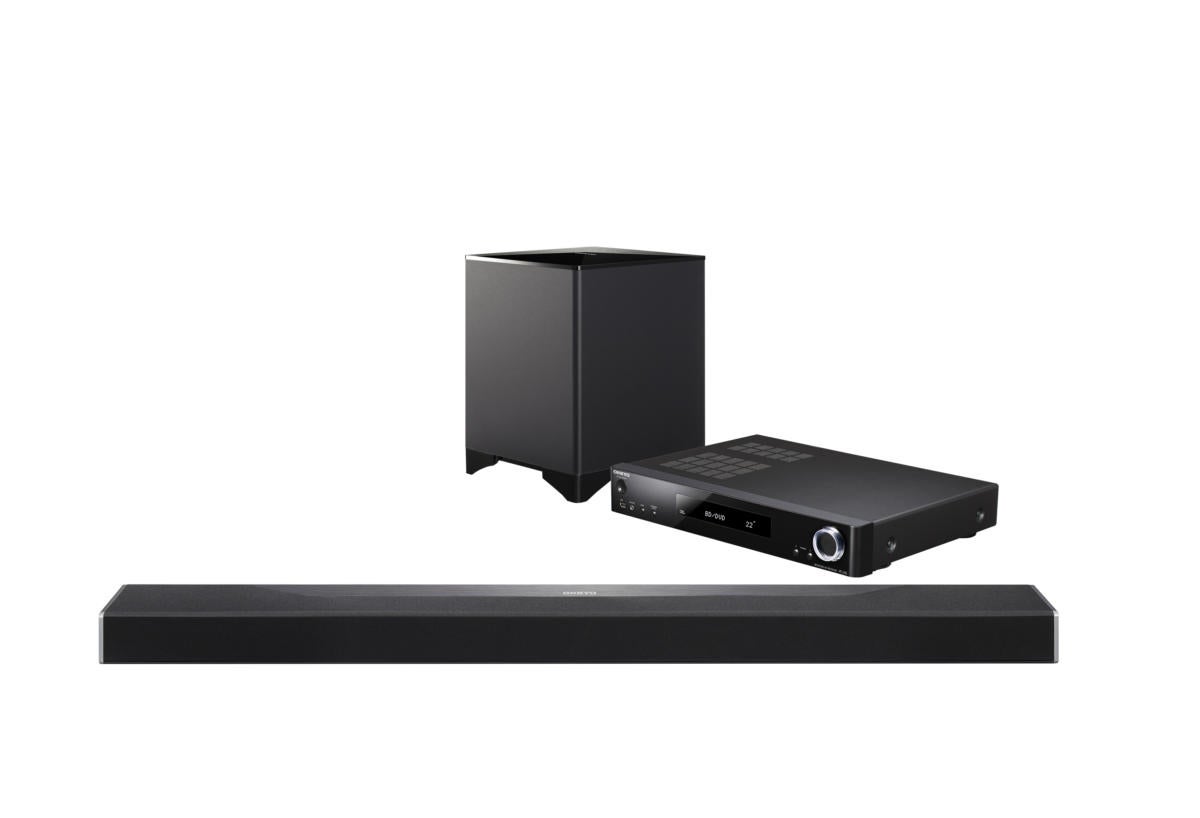 Onkyo
Onkyo
The Onkyo STB-A500 soundbar includes an AV receiver as part of the package.
Soundbar features you should look for
Sorting through different soundbars can be a dizzying experience. Here’s an alphabetized list of some of the most important features you’ll encounter
App control: If you want to control everything from your smartphone or tablet, you’ll want to know if the manufacturer offers an app for your mobile operating system of choice.
ARC: The acronym stands for Audio Return Channel. First introduced with HDMI 1.4, ARC enables your TV to send its audio output back through the HDMI cable to your soundbar or A/V receiver. This is especially important if you’re using your smart-TV’s onboard tuner or any of its media-streaming apps (Netflix, YouTube, Vudu, etc.).
Dialog enhancement: If you find yourself turning on closed captions because you can’t make out what people on your TV are saying, you might want to invest in a soundbar that offers dialog enhancement. This feature uses an algorithm that identifies frequencies commonly associated with speech and runs them through a digital signal processor to make them easier to distinguish from sound effects, music, and other background audio.
 Yamaha
Yamaha The Yamaha YSP-5600 is a 7.1.2 soundbar capable of supporting Dolby Atmos and DTS:X object-oriented audio formats. There are 44 beam drivers and two woofers in the sound bar that produce the surround and height effects.
Dolby Atmos and DTS:X: Some of today’s top-of-the-line soundbars will let you take advantage of the latest object-oriented audio technologies, such as Dolby Atmos and DTS:X. Soundbars that feature object-oriented audio, are typically limited to 5.1.2 or 7.1.2 configuration, where they only reproduce the front two height effects channels. (A 5.1.2-channel system has front left, center, front right, left surround, right surround, subwoofer, left height, and right height. A 7.1.2-channel is the same configuration plus left rear surround and right rear surround.)
EQ: Some soundbars have onboard EQ (equalization) to help tune the soundbar for a particular placement, such as on the wall or in a cabinet. The EQ adjusts certain sonic characteristics that happen to the speaker in a typical scenario, but don’t confuse EQ with room correction. Room correction far more sophisticated.
HDMI 2.0a If you don’t already have a 4K UHD TV that supports HDR (high dynamic range), the next set you buy probably will. You can learn more about HDR in this story, but it basically pumps up the contrast to reveal more detail and produce vibrant color. You’ll need a soundbar that supports HDMI 2.0a to ensure HDR information is passed through the soundbar from the source (e.g., an Ultra HD Blu-ray player) to your television.
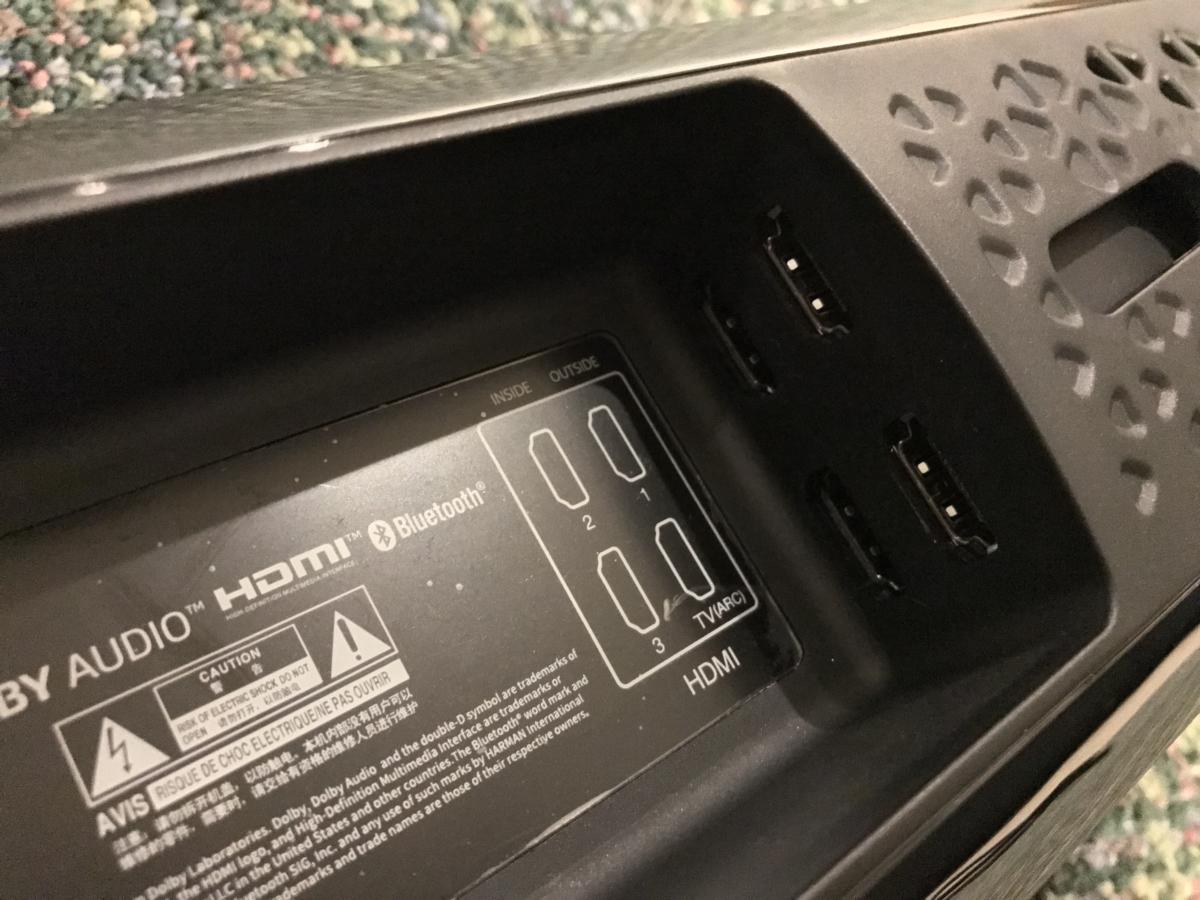 Theo Nicolakis / IDG
Theo Nicolakis / IDGThe JBL SB450 has multiple HDMI inputs.
Lossless audio: Do you have a growing collection of high-resolution music files in FLAC or ALAC formats? If you want to listen to them through your soundbar, you’ll want to make sure it can decode those files.
Multi-room audio: Some soundbars can be components in a multi-room audio system, but this usually entails choosing one platform and sticking with it all over your home (speakers that support DTS Play-Fi are an exception to that rule). The more typical proprietary systems include Denon’s Heos, Yamaha’s MusicCast, and—one of the most popular systems—Sonos. Sonos even allows you to pair its Playbar or Playbase with its wireless subwoofer and wireless satellite speakers (the Play:1, Play:3, or the second-generation Play:5) as surround channels to create a true 5.1-channel surround-sound setup. But you can’t go beyond that to add rear surrounds or height channels with a Sonos system.
Music streaming: Many of today’s soundbars can stream music over Wi-Fi or Bluetooth, but only a handful support Bluetooth with aptX for near CD-quality streaming. Apple’s AirPlay is an important feature for Apple enthusiasts with iPhones and iPods. Audio enthusiasts will want to know if the soundbar can decode lossless codecs such as FLAC and ALAC.
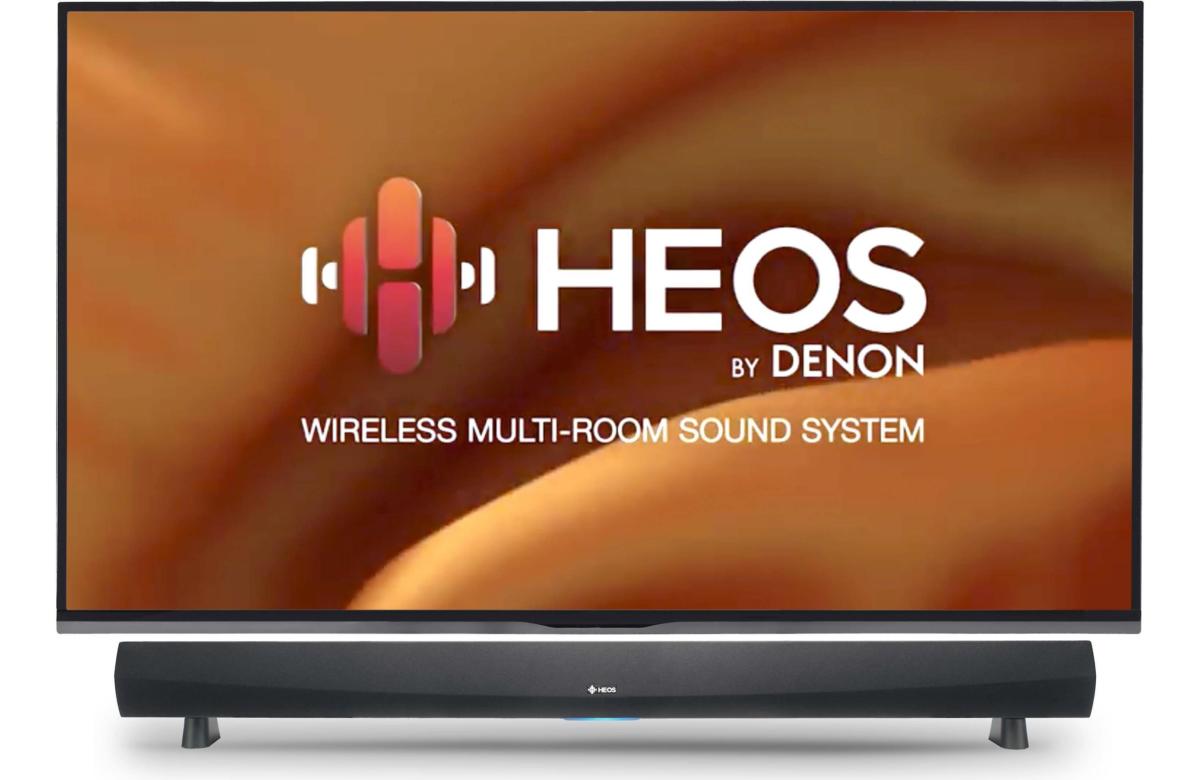 Denon
DenonThe HomeCinema sound bar ties in seamlessly with Denon’s Heos streaming ecosystem.
Room correction: Your room plays a critical part in how your soundbar will sound. Some manufacturers, such as Paradigm, build sophisticated and highly effective room-correction technology into their soundbars. The sonic benefits of a good soundbar with well-implemented room correction can be jaw-dropping, but that feature is usually expensive. You’ll typically won’t find room correction in soundbars priced less than $1,000.
Subwoofer support: If you love good, deep bass, then you’ll want to scope out a soundbar that can connect to a subwoofer. Some soundbars come pre-packaged with a sub (in many cases, a wireless model), while others provide a subwoofer output so you can use a cable to hook up your model of choice. The pre-packaged route might look attractive, but it typically means you can’t upgrade either component without junking them both.